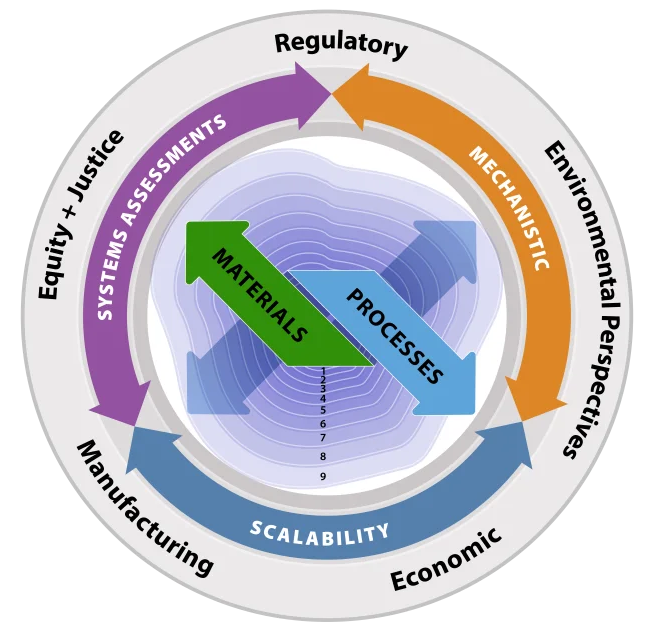Recent research published in Nature Reviews Chemistry highlights a roadmap developed by scientists at Oak Ridge National Laboratory and six other Department of Energy national laboratories to achieve net-zero carbon emissions in the US. Their strategy emphasizes "defossilization," which involves reducing reliance on fossil fuels and reusing existing carbon rather than capturing or storing it.

Creating a “circular economy” that reclaims much of the existing carbon in fossil-fueled power generation and difficult-to-recycle materials could lead to “defossilization.” For this to happen, the technology must be energy efficient, cost effective, and scalable with equitable and ecological solutions to ensure that all communities will benefit. Image Credit: Andy Sproles/ORNL, U.S. Dept. of Energy
Researchers from DOE laboratories, including ORNL, Pacific Northwest National Laboratory, Brookhaven National Laboratory, Argonne National Laboratory, Lawrence Berkeley National Laboratory, Ames National Laboratory, and SLAC National Accelerator Laboratory, combined their expertise to develop a roadmap aimed at "defossilizing" sectors of the US economy. Their goal is to reduce carbon emissions from segments of the market that pose challenges for electrification.
The breadth of this research shows the benefit of collaboration across our national laboratories. Carbon is a vital part of many of today’s products and processes, and we must be creative in how to address its use in the face of global climate change.
Stephen Streiffer, Director, Oak Ridge National Laboratory
Decarbonization efforts typically focus on capturing or sequestering carbon emissions. In contrast, defossilization seeks to reduce or eliminate the need for new fossil fuel extraction. This approach involves recovering carbon from existing processes and products and repurposing it rather than merely storing it.
This shift towards a "circular economy" aims to recycle a substantial portion of the existing carbon from sources like fossil-fueled power generation, as well as hard-to-use materials such as biomass, municipal waste, biomethane, carbon dioxide, and plastics.
Defossilization could significantly reduce new emissions from the transportation and industrial sectors, which together account for over 50 % of the nation's carbon footprint. These sectors have had quite a hard time transitioning from fossil fuels to electricity, a process known as electrification. Although there is ongoing industrial and scientific research focused on finding clean technologies or alternative materials, key segments of the economy will still require carbon for their operations.
Michelle K. Kidder, a prominent researcher and program manager for ORNL's DOE Fossil Energy Carbon Management decarbonization portfolio, concentrates on integrating novel material development for chemical reactions and separations across atomic-to-industrial process levels to advance sustainable and renewable clean energy technologies. She emphasizes that achieving defossilization in sectors that are difficult to electrify will necessitate speeding up the pace of discovery for transformative technologies.
Maintaining today’s 15- to 20-year discover-design-develop-deploy cycle will not allow us to slow, stop, or even reverse climate impacts in time to meet aggressive 2030 and 2050 U.S. targets. We must instead find new ways to approach fundamental advancements in science and more quickly translate discoveries into applications that can make significant impact on emissions reductions.
Michelle K. Kidder, Oak Ridge National Laboratory
To foster broader, more affordable, equitable, and inclusive defossilization efforts, hundreds of scientists and technical experts from across the national laboratory system are collaborating to overcome longstanding scientific and technological challenges. Research conducted at ORNL aims to reduce the nation's carbon footprint without excessively straining other resources, such as water and precious metals.
These researchers are integrating chemistry, artificial intelligence, and machine learning to predict properties for novel materials. They utilize ORNL's Frontier, the world's fastest supercomputer, for high-performance computations while designing and modeling new energy technologies, including next-generation fusion and advanced fission nuclear reactors.
While their work is grounded in scientific principles, they now also incorporate techno-economic and lifecycle analyses. This helps identify potential environmental and social impact challenges associated with emerging technologies.
Kidder stresses the importance of comprehensive systemwide analyses that consider technical, environmental, economic, political, and social factors.
Even as we look for alternatives to reusing and keeping carbon in play, defossilization must allow equitable and ecological solutions for everyone. If we can bring this vision to fruition at the urgent pace needed, we also can reduce carbon dioxide and its consequent impact on the environment while ensuring that no community is left behind.
Michelle K. Kidder, Oak Ridge National Laboratory
Journal Reference:
Shaw, W. J., et al. (2024) A US perspective on closing the carbon cycle to defossilize difficult-to-electrify segments of our economy. Nature Reviews Chemistry. doi.org/10.1038/s41570-024-00587-1.